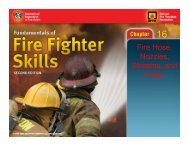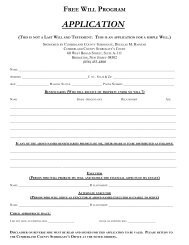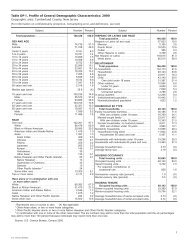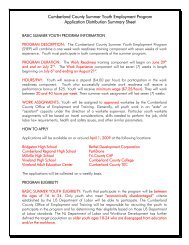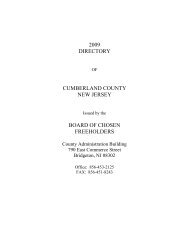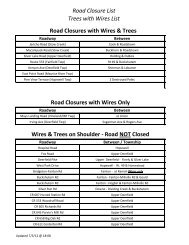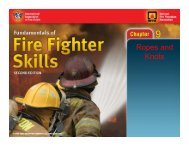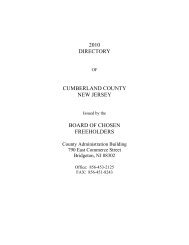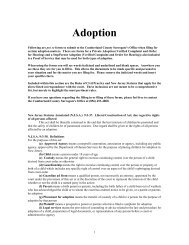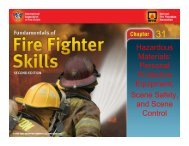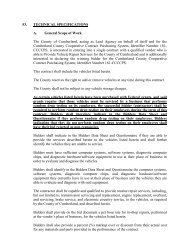Portable Fire Extinguishers
Portable Fire Extinguishers
Portable Fire Extinguishers
You also want an ePaper? Increase the reach of your titles
YUMPU automatically turns print PDFs into web optimized ePapers that Google loves.
7<br />
<strong>Portable</strong> <strong>Fire</strong><br />
<strong>Extinguishers</strong>
Objectives (1 of 3)<br />
• State the primary purposes of fire<br />
extinguishers.<br />
• Define Class A fires.<br />
• Define Class B fires.<br />
• Define Class C fires.<br />
• Define Class D fires.<br />
• Define Class K fires.<br />
7
Objectives (2 of 3)<br />
• Explain the classification and rating<br />
system for fire extinguishers.<br />
• Describe the types of agents used in fire<br />
extinguishers.<br />
• Describe the types of operating systems in<br />
fire extinguishers.<br />
7
Objectives (3 of 3)<br />
• Describe the basic steps of fire<br />
extinguisher operation.<br />
• Explain the basic steps of inspecting,<br />
maintaining, recharging, and hydrostatic<br />
testing of fire extinguishers.<br />
7
• <strong>Portable</strong> fire<br />
extinguishers are<br />
required in a variety<br />
of occupancies.<br />
• <strong>Extinguishers</strong> are<br />
used by citizens and<br />
fire fighters.<br />
• Easy to operate with<br />
minimal training<br />
Introduction (1 of 2)<br />
7
Introduction (2 of 2)<br />
• <strong>Extinguishers</strong> vary in size and type of<br />
extinguishing agent used.<br />
• Selection of appropriate extinguisher is<br />
critical.<br />
• Proper use reduces injury and property<br />
damage.<br />
7
Purposes of <strong>Fire</strong><br />
<strong>Extinguishers</strong> (1 of 2)<br />
• Extinguish incipient fires<br />
• Control fires where traditional suppression<br />
methods not recommended<br />
• Most departments carry at least one.<br />
• Often used by fire fighters for incipient<br />
fires<br />
7
Purposes of <strong>Fire</strong><br />
<strong>Extinguishers</strong> (2 of 2)<br />
• Must know<br />
– Which fires require<br />
special extinguishing<br />
agents<br />
– What type of<br />
extinguisher to use<br />
– How to operate each<br />
type of extinguisher<br />
7
Classes of <strong>Fire</strong>s<br />
• Essential to match extinguisher and fire<br />
• Grouped by their characteristics<br />
• Some agents are more efficient on certain<br />
fires.<br />
• Some agents will not control certain fires.<br />
• Some agents are dangerous when applied<br />
to certain fires.<br />
7
• Class A fires involve<br />
items such as:<br />
– Ordinary wood<br />
– Rubber<br />
– Household rubbish<br />
– Natural vegetation<br />
• Water is most<br />
common<br />
extinguishing agent.<br />
Class A <strong>Fire</strong>s<br />
7
• Class B fires involve<br />
items such as:<br />
– Flammable liquids and<br />
gases<br />
– Oil and grease<br />
– Tar<br />
– Some plastics<br />
• Several agents can<br />
be used.<br />
Class B <strong>Fire</strong>s<br />
7
• Class C fires involve<br />
energized electrical<br />
equipment such as:<br />
– Building wiring<br />
– Circuit breakers<br />
– Transformers<br />
– Power tools<br />
• Require agents that<br />
are not conductors.<br />
Class C <strong>Fire</strong>s<br />
7
• Class D fires involve<br />
combustible metals<br />
– Magnesium<br />
– Sodium<br />
– Lithium<br />
– Potassium<br />
• Violent reactions to<br />
water and other<br />
agents can occur.<br />
Class D <strong>Fire</strong>s<br />
7
• New classification<br />
due to cooking trends<br />
• Involve combustible<br />
cooking oils and fats<br />
• Some restaurants still<br />
use Class B<br />
extinguishers.<br />
Class K <strong>Fire</strong>s<br />
7
Classification of<br />
<strong>Fire</strong> <strong>Extinguishers</strong> (1 of 5)<br />
• Classification and rating is based on<br />
characteristics and capabilities.<br />
• Underwriters Laboratories, Inc. (UL)<br />
develops standards for ratings and<br />
classification.<br />
• Rated for safety and effectiveness<br />
• May have multiple letters if effective on<br />
more than one class of fire<br />
7
Classification of<br />
<strong>Fire</strong> <strong>Extinguishers</strong> (2 of 5)<br />
• Letters indicate class of fire for which<br />
extinguisher can be used.<br />
• Numbers indicate effectiveness for Class<br />
A and B extinguishers by a nonexpert<br />
user.<br />
7
Classification of<br />
<strong>Fire</strong> <strong>Extinguishers</strong> (3 of 5)<br />
• Class A fire extinguishers<br />
– Number is related to amount of water.<br />
– 1-A rated contains equivalent of 1.25 gallons<br />
of water.<br />
– 2-A rated contains equivalent of 2.5 gallons of<br />
water.<br />
– 4-A rated should extinguish approximately<br />
twice as much fire as a 2-A rated.<br />
7
Classification of<br />
<strong>Fire</strong> <strong>Extinguishers</strong> (4 of 5)<br />
• Class B fire extinguishers<br />
– Number is based on approximate square feet<br />
of burning fuel that can be extinguished.<br />
– 10-B rated will extinguish 10 square feet of<br />
fire.<br />
– 40-B rated will extinguish 40 square feet of<br />
fire.<br />
7
Classification of<br />
<strong>Fire</strong> <strong>Extinguishers</strong> (5 of 5)<br />
• Class C extinguishers use agents that do<br />
not conduct electricity.<br />
• Standard test fires<br />
– Used to rate the effectiveness of fire<br />
extinguishers<br />
– May involve different agents, amounts,<br />
application rates, and application amounts<br />
7
Labeling of <strong>Fire</strong> <strong>Extinguishers</strong><br />
(1 of 3)<br />
• Traditional lettering<br />
system:<br />
– Class A = Green<br />
triangle<br />
– Class B = Red square<br />
– Class C = Blue circle<br />
– Class D = Yellow star<br />
• No traditional label for<br />
Class K<br />
7
Labeling of <strong>Fire</strong> <strong>Extinguishers</strong><br />
(2 of 3)<br />
• Pictograph system:<br />
– Square icons<br />
represent each class<br />
of fire.<br />
– Class A, Class B,<br />
Class C, and Class K<br />
have pictographs.<br />
7
Labeling of <strong>Fire</strong> <strong>Extinguishers</strong><br />
(3 of 3)<br />
• Icon represents the rating for the class of<br />
fire.<br />
• No icon = no rating<br />
• Red slash indicates that the extinguisher<br />
must not be used on that type of fire.<br />
7
<strong>Fire</strong> Extinguisher Placement<br />
(1 of 2)<br />
• National <strong>Fire</strong> Protection Association<br />
(NFPA) 10 lists recommendations for<br />
placing and mounting portable fire<br />
extinguishers.<br />
• Occupancy regulations specify area<br />
protected, travel distance from<br />
extinguisher to fire, and types of<br />
extinguishers provided.<br />
7
<strong>Fire</strong> Extinguisher Placement<br />
(2 of 3)<br />
• Two factors to consider to determine the<br />
type of extinguisher:<br />
– Class of fire likely to occur<br />
– Potential magnitude of an incipient fire<br />
7
<strong>Fire</strong> Extinguisher Placement<br />
(3 of 3)<br />
• <strong>Extinguishers</strong> should<br />
be readily visible and<br />
easily accessed.<br />
• Do not mount heavy<br />
extinguishers high on<br />
a wall.<br />
• NFPA 10<br />
recommends<br />
mounting heights.<br />
7
Classifying Area Hazards<br />
• <strong>Fire</strong> load<br />
– Quantity of combustible materials present<br />
– Includes building materials, contents, and<br />
furnishings<br />
– Measured as the average weight of<br />
combustibles per square foot<br />
– The larger the load, the larger the potential<br />
fire<br />
7
Light or Low Hazard (1 of 2)<br />
• Areas where the majority of materials are<br />
noncombustible<br />
• Arranged so that a fire is not likely to<br />
spread<br />
• Contain limited amounts of Class A and<br />
Class B combustibles<br />
7
Light or Low Hazard (2 of 2)<br />
• Common light hazard<br />
environments include:<br />
– Offices<br />
– Classrooms<br />
– Churches<br />
– Hotel guest rooms<br />
7
Ordinary or Moderate Hazard<br />
• Contain more Class A<br />
and Class B materials<br />
than light hazard<br />
locations<br />
• Examples include:<br />
– Auto showrooms<br />
– Research facilities<br />
– Parking garages<br />
7
Extra or High Hazard (1 of 2)<br />
• Contain more Class A and Class B<br />
materials than ordinary hazard locations<br />
• Class I commodities<br />
• Class II commodities<br />
7
Extra or High Hazard (2 of 2)<br />
• Examples include:<br />
– Woodworking shops<br />
– Kitchens that have<br />
deep fryers, flammable<br />
liquids, or gases under<br />
pressure<br />
– Facilities used for<br />
storing flammable<br />
liquids<br />
7
Determining the Appropriate<br />
Placement of <strong>Fire</strong> Extinguisher<br />
• Consider the types and quantities of fuels<br />
found in the area.<br />
• Multipurpose dry chemical extinguishers<br />
are often used in areas containing low to<br />
moderate hazards.<br />
• Facilities present a variety of conditions.<br />
– Evaluate each area and tailor the installation.<br />
7
Methods of <strong>Fire</strong><br />
Extinguishment (1 of 2)<br />
• <strong>Fire</strong>s require fuel, heat, and oxygen.<br />
• Rapid oxidation<br />
– Occurs when a fuel is combined with oxygen<br />
• Combustion<br />
– Occurs when fuel is heated to its kindling<br />
temperature<br />
7
Methods of <strong>Fire</strong><br />
Extinguishment (2 of 2)<br />
• <strong>Extinguishers</strong> stop<br />
burning by:<br />
– Cooling the fuel<br />
– Cutting off the supply<br />
of oxygen<br />
– Interrupting the chain<br />
of reactions<br />
7
Extinguishing Agents<br />
• Substance contained in portable fire<br />
extinguisher that puts out a fire<br />
• Various chemicals are used (including<br />
water).<br />
• Best agent for a particular hazard depends<br />
on several factors.<br />
– Types of materials involved<br />
– Anticipated size of the fire<br />
7
• Water<br />
Types of Extinguishing<br />
• Dry chemicals<br />
• Carbon dioxide<br />
• Foam<br />
• Wet chemicals<br />
• Halogenated agents<br />
• Dry powder<br />
Agents<br />
7
Water<br />
• Efficient, plentiful, and inexpensive<br />
• Converts from liquid to steam<br />
• Effective on Class A fires<br />
• Less effective or dangerous on other<br />
classes<br />
• Loaded-stream extinguishers<br />
• Wetting agents<br />
7
Dry Chemical (1 of 3)<br />
• Stream of finely ground particles<br />
• Different types of compounds are used.<br />
• Extinguish in two ways:<br />
– Interrupts chemical chain reaction<br />
– Absorbs large quantities of heat<br />
7
• Several advantages<br />
over water<br />
extinguishers<br />
Dry Chemical (2 of 3)<br />
• Ordinary: Suitable for<br />
Class B and C fires<br />
• Multipurpose: Rated<br />
for Class A, B, and C<br />
fires<br />
7
Dry Chemical (3 of 3)<br />
• Additives prevent packing and caking.<br />
• Disadvantage: Chemicals are corrosive.<br />
• Primary compounds:<br />
– Sodium bicarbonate<br />
– Potassium bicarbonate<br />
– Urea-based potassium carbonate<br />
– Potassium chloride<br />
– Ammonium phosphate<br />
7
Carbon Dioxide (1 of 3)<br />
• 1.5 times heavier than air<br />
• Forms a dense cloud displacing air<br />
surrounding the fuel<br />
• Interrupts combustion by<br />
– Reducing the oxygen<br />
– Disrupting liquid fuel’s ability to vaporize<br />
7
Carbon Dioxide (2 of 3)<br />
• Stored under<br />
pressure as a liquid<br />
• Rated for Class B and<br />
C fires only<br />
7
Carbon Dioxide (3 of 3)<br />
• Limitations include:<br />
– Weight<br />
– Range<br />
– Weather<br />
– Confined spaces<br />
– Suitability<br />
7
Foam (1 of 2)<br />
• Water-based foam concentrate solution<br />
• Nozzles introduce air to form foam<br />
blanket.<br />
• Use on Class A or B fires.<br />
• Additives depend on compatibility with<br />
fuels.<br />
7
• Some foams are<br />
approved for polar<br />
solvents.<br />
• Not suitable for Class<br />
C fires<br />
• Cannot be stored or<br />
used at freezing<br />
temperatures<br />
Foam (2 of 2)<br />
7
Wet Chemical<br />
• Only agent to meet Class K fire rating<br />
• Formulated for use in commercial kitchens<br />
• Saponification<br />
• Creates thick blanket to smother the fire<br />
and prevent re-ignition<br />
• Discharged as a fine spray<br />
• Very effective and easy to clean up<br />
7
Halogenated Agents (1 of 2)<br />
• Produced from family of liquefied gases<br />
• Clean agents<br />
• Twice as effective as carbon dioxide<br />
• Two categories<br />
– Halons: Use limited by Montreal Protocol<br />
– Halocarbons: Replaced halons<br />
7
Halogenated Agents (2 of 2)<br />
• Stored as liquids and discharged under<br />
high pressure<br />
• Vapor mist disrupts chain reaction.<br />
• Dissipate in windy conditions<br />
• Displace oxygen in confined spaces<br />
• Halon 1211 should rarely be used.<br />
• Four agents in portable extinguishers<br />
7
Dry Powder<br />
• Used on combustible metal fires (Class D)<br />
• Stored in granular or powdered form<br />
• Forms solid crust over burning metal<br />
• Sodium chloride or graphite powder<br />
• Avoid splatter.<br />
• Violent reactions can result from any trace<br />
quantities of water.<br />
7
<strong>Fire</strong> Extinguisher Design<br />
• Use pressure to expel contents<br />
• Many extinguishers require pressurized<br />
gas to expel the agent.<br />
• Some agents are self-expelling.<br />
• Hand-operated pumps expel water or<br />
water with additives.<br />
7
<strong>Portable</strong> <strong>Fire</strong> Extinguisher<br />
Components (1 of 7)<br />
• Most hand-held<br />
extinguishers have six<br />
basic parts:<br />
– Cylinder or container<br />
– Carrying handle<br />
– Nozzle or horn<br />
– Trigger<br />
– Locking mechanism<br />
– Pressure indicator<br />
7
<strong>Portable</strong> <strong>Fire</strong> Extinguisher<br />
Components (2 of 7)<br />
• Cylinder or container<br />
– Body of the extinguisher<br />
– Holds the extinguishing agent<br />
– Nitrogen, compressed air, or carbon dioxide<br />
used to pressurize the cylinder<br />
– Gas can be stored internally (stored-pressure)<br />
or externally (cartridge/cylinder).<br />
7
<strong>Portable</strong> <strong>Fire</strong> Extinguisher<br />
• Handle<br />
Components (3 of 7)<br />
– Used to carry an extinguisher and to hold it<br />
during use<br />
– <strong>Extinguishers</strong> weighing more than 3 lbs must<br />
have handles.<br />
– Usually located just below the trigger<br />
mechanism<br />
7
<strong>Portable</strong> <strong>Fire</strong> Extinguisher<br />
Components (4 of 7)<br />
• Nozzle or horn<br />
– Expels agent<br />
– Attached directly to valve assembly or at the<br />
end of a short hose<br />
– Foam extinguishers have a special aspirating<br />
nozzle.<br />
7
<strong>Portable</strong> <strong>Fire</strong> Extinguisher<br />
• Trigger<br />
Components (5 of 7)<br />
– Mechanism that is squeezed or depressed to<br />
discharge extinguishing agent<br />
– Usually a lever located above the handle<br />
– Cartridge/cylinder models usually have a twostep<br />
operating sequence.<br />
7
<strong>Portable</strong> <strong>Fire</strong> Extinguisher<br />
Components (6 of 7)<br />
• Locking mechanism<br />
– Prevents accidental discharge<br />
– Simplest form is a stiff pin<br />
• Inserted through a hole in the trigger<br />
• Usually has a ring at the end<br />
– Tamper seal<br />
• Secures the pin<br />
• Discourages people from tinkering with<br />
extinguisher<br />
7
<strong>Portable</strong> <strong>Fire</strong> Extinguisher<br />
Components (7 of 7)<br />
• Pressure indicator<br />
– Shows whether a stored-pressure<br />
extinguisher has sufficient pressure to operate<br />
– Most extinguishers use a needle gauge.<br />
– Some disposable extinguishers have a pin<br />
that, when pressed, tests the pressure.<br />
7
Wheeled <strong>Fire</strong> <strong>Extinguishers</strong><br />
• Large units mounted on wheeled carriages<br />
• Typically contain 150 to 350 lbs<br />
• Indoor use requires wide doors and aisles.<br />
• Long delivery hoses allow operators to<br />
attack fire from multiple sides.<br />
• Usually pressurized by separate cylinders<br />
• Installed in special hazard areas<br />
7
<strong>Fire</strong> Extinguisher<br />
Characteristics (1 of 2)<br />
• <strong>Portable</strong> extinguishers vary according to<br />
– Extinguishing agent<br />
– Capacity<br />
– Effective range<br />
– Time it takes to completely discharge agent<br />
• <strong>Extinguishers</strong> also have different<br />
mechanical designs.<br />
7
<strong>Fire</strong> Extinguisher<br />
Characteristics (2 of 2)<br />
• Seven types of extinguishers:<br />
– Water<br />
– Dry chemical<br />
– Carbon dioxide<br />
– Class B foam<br />
– Wet chemical<br />
– Halogenated agent<br />
– Dry powder<br />
7
Water <strong>Extinguishers</strong> (1 of 6)<br />
• Used to cool burning fuel below its ignition<br />
temperature<br />
• Intended primarily for Class A fires<br />
7
Water <strong>Extinguishers</strong> (2 of 6)<br />
• Stored-pressure<br />
water-type<br />
– Used for incipient<br />
Class A fires<br />
– Contents can freeze<br />
– Can be recharged at<br />
any location that<br />
provides water and a<br />
source of compressed<br />
air<br />
7
Water <strong>Extinguishers</strong> (3 of 6)<br />
• Loaded-stream water-type<br />
– Discharge solution of water containing an<br />
alkali metal salt<br />
– Usable to -40 ºF<br />
– Most common model is 2.5 gallon unit.<br />
– Larger units are pressurized by separate<br />
cylinder of carbon dioxide.<br />
7
Water <strong>Extinguishers</strong> (4 of 6)<br />
• Wetting agent, Class A foam water-type<br />
– Solution reduces surface tension.<br />
– Allows water to penetrate Class A<br />
– Foam concentrate reduces surface tension<br />
and creates foam.<br />
– Configurations same as hand-held and<br />
wheeled models<br />
– Do not expose to temperatures below 40 ºF.<br />
7
Water <strong>Extinguishers</strong> (5 of 6)<br />
• Pump-tank water-type<br />
– Range from 1-A rated, 1.5-gallon units, to 4-A<br />
rated, 5-gallon units<br />
– Nonpressurized storage<br />
– Expelled via hand-operated piston pump<br />
– Sits upright on the ground<br />
– Can be used with antifreeze solution<br />
7
Water <strong>Extinguishers</strong> (6 of 6)<br />
• Backpack water-type<br />
– Used primarily for<br />
brush and grass fires<br />
– Water tank made of<br />
fiberglass, stainless or<br />
galvanized steel, or<br />
brass<br />
– Wide mouth opening<br />
with filter allows easy<br />
refill.<br />
7
Dry Chemical <strong>Extinguishers</strong><br />
(1 of 4)<br />
• Contain variety of agents in granular form<br />
• Ordinary models extinguish Class A and B<br />
fires.<br />
• Multipurpose models extinguish Class A,<br />
B, and C fires.<br />
• All can be used on Class C fires, but<br />
residue damages electronics.<br />
7
Dry Chemical <strong>Extinguishers</strong><br />
(2 of 4)<br />
• Discharge time is 8 to 20 seconds in small<br />
models, up to 30 seconds in larger units.<br />
• Range of discharge is from 5' to 30',<br />
depending on size.<br />
• Trigger allows intermittent discharge.<br />
• <strong>Extinguishers</strong> do not retain internal<br />
pressure for extended periods.<br />
7
Dry Chemical <strong>Extinguishers</strong><br />
(3 of 4)<br />
• Disposable models not refillable<br />
• Can be stored at temperatures below<br />
freezing<br />
• Ordinary<br />
– Available in hand-held models up to 160-B:C<br />
– Wheeled units carry up to 640-B:C.<br />
7
Dry Chemical <strong>Extinguishers</strong><br />
(4 of 4)<br />
• Multipurpose<br />
– Aluminum phosphate agent<br />
– Hand-held models 1-A to 20-A, 10-B:C to<br />
120-B:C<br />
– Large wheeled units 20-A to 40-A, 60-B:C to<br />
320 B:C<br />
– Should never be used for Class K fires<br />
7
Carbon Dioxide <strong>Extinguishers</strong><br />
(1 of 3)<br />
• Rated for Class B and C fires<br />
• Extinguishes by enveloping fuel in a cloud<br />
of inert gas<br />
• Also cools the burning material<br />
• 1.5 times heavier than air<br />
• Colorless, odorless, nonconductive, and<br />
inert<br />
7
Carbon Dioxide <strong>Extinguishers</strong><br />
(2 of 3)<br />
• Is noncorrosive<br />
• Both an expelling agent and an<br />
extinguishing agent<br />
• Have relatively short discharge ranges<br />
• Not recommended outdoors or near strong<br />
air currents<br />
7
Carbon Dioxide <strong>Extinguishers</strong><br />
(3 of 3)<br />
• Trigger mechanism allows intermittent<br />
operation.<br />
• Metal horns no longer made, but some<br />
units may still be in service and are not<br />
compatible for Class C fires.<br />
7
Class B Foam <strong>Extinguishers</strong><br />
• Aspirating nozzle discharges solution of<br />
water and AFFF or FFFP agent.<br />
• Discharged through an aspirating nozzle<br />
• Foam blanket floats over surface of liquid.<br />
• Effective for Class A and B fires, but not<br />
suitable for Class C or K fires<br />
• Not effective at freezing temperatures<br />
7
Wet Chemical <strong>Extinguishers</strong><br />
• Used to protect Class K installations<br />
– Cooking oils, deep fryers, and grills<br />
• Commercial facilities use fixed, automatic<br />
systems.<br />
• <strong>Portable</strong> extinguishers available in 1.5gallon<br />
and 2.5-gallon sizes<br />
• No numerical ratings<br />
7
Halogenated-Agent<br />
<strong>Extinguishers</strong><br />
• Include both halon and halocarbon agents<br />
• Use of halon agents is strictly controlled<br />
due to environmental hazards.<br />
• Available in hand-held models rated for<br />
Class B and C fires<br />
• Agent discharged as a streaming liquid<br />
• They are nonconductive and leave no<br />
residue.<br />
7
Dry Powder Extinguishing<br />
Agents (1 of 2)<br />
• For Class D fires involving combustible<br />
metals<br />
• Agents and techniques vary.<br />
• Each agent listed for use on specific<br />
combustible metal fires<br />
7
Dry Powder Extinguishing<br />
Agents (2 of 2)<br />
• Dry powder fire extinguishers<br />
– -Have adjustable nozzles that allow operator<br />
to vary the flow of agent<br />
• Bulk dry powder agents<br />
– -Available in 40 lb and 50 lb pails and 350 lb<br />
drums<br />
– -Applied manually using a shovel or scoop<br />
7
Use of <strong>Fire</strong> <strong>Extinguishers</strong><br />
• Six basic steps for extinguishing fires:<br />
– Locate the fire.<br />
– Select the proper extinguisher.<br />
– Transport the extinguisher to the fire.<br />
– Activate the extinguisher to release the agent.<br />
– Apply the extinguishing agent.<br />
– Ensure personal safety.<br />
• Practice and training are essential.<br />
7
Locating a <strong>Fire</strong> Extinguisher<br />
• Know the types and locations of<br />
extinguisher on apparatus.<br />
• Know where extinguishers are located in<br />
and around the fire station.<br />
• Have at least one extinguisher in your<br />
home and another in your personal<br />
vehicle.<br />
7
Selecting the Proper<br />
Extinguisher<br />
• Requires an understanding of the<br />
classification and rating system<br />
• <strong>Fire</strong> fighters must quickly determine if a<br />
fire can be controlled by an extinguisher.<br />
• <strong>Fire</strong> fighters should also determine the<br />
appropriate type of extinguisher to place in<br />
a given area.<br />
7
Transporting a <strong>Fire</strong><br />
Extinguisher<br />
• Best method depends on size, weight, and<br />
design of extinguisher.<br />
• Carry fixed nozzle units in stronger hand.<br />
• Use weaker hand for units with a hose<br />
between trigger and nozzle.<br />
• Place heavier extinguishers on ground<br />
near fire; one hand to depress trigger, one<br />
hand to hold nozzle and direct stream.<br />
7
Basic Steps of<br />
<strong>Fire</strong> Extinguisher Operation<br />
• P-A-S-S acronym:<br />
– Pull the safety pin.<br />
– Aim the nozzle at the base of the flames.<br />
– Squeeze the trigger to discharge agent.<br />
– Sweep the nozzle across the base of the<br />
flames.<br />
• Practice discharging different types of<br />
extinguishers.<br />
7
Ensure Your Personal Safety<br />
• Approach fire with an exit behind you.<br />
• Have a planned escape route.<br />
• Never let fire get between you and exit.<br />
• Never turn your back on the fire.<br />
• Watch fire for rekindle.<br />
• Wear appropriate PPE and SCBA.<br />
7
Care of <strong>Fire</strong> <strong>Extinguishers</strong><br />
• <strong>Extinguishers</strong> must be regularly inspected<br />
and properly maintained.<br />
• Records keep inspections and<br />
maintenance on schedule.<br />
• Proper training required for inspection and<br />
maintenance.<br />
• Follow manufacturer’s recommendations.<br />
7
Inspection (1 of 2)<br />
• “Quick check” verifies availability for<br />
immediate use.<br />
• Check extinguishers on apparatus<br />
regularly.<br />
• Check tamper seals.<br />
• Weigh or “heft” to determine fullness.<br />
• Examine for obvious physical damage,<br />
corrosion, or leaks.<br />
7
Inspection (2 of 2)<br />
• Check pressure gauge.<br />
• Confirm proper identification by type and<br />
rating.<br />
• Shake dry chemicals to mix agent.<br />
• Check nozzle for damage or obstructions.<br />
• Take problem units out of service and<br />
replace with spares.<br />
7
Maintenance<br />
• Maintenance includes internal inspections<br />
and repairs.<br />
• Maintenance must be performed<br />
periodically.<br />
• An inspection may reveal the need for<br />
maintenance.<br />
• Only qualified personnel can perform<br />
maintenance.<br />
7
Common Indicators<br />
of Need for Maintenance (1 of 2)<br />
• Pressure gauge reads outside normal<br />
range<br />
• Out-of-date inspection tag<br />
• Broken tamper seal<br />
• Any indication that unit is not full<br />
7
Common Indicators<br />
of Need for Maintenance (2 of 2)<br />
• Obstruction of hose and/or nozzle<br />
assembly<br />
• Signs of physical damage, corrosion, or<br />
rust<br />
• Visible signs of leakage around discharge<br />
valve or nozzle assembly<br />
7
Recharge (1 of 2)<br />
• Required after every use<br />
• Take extinguisher out of service<br />
immediately after use.<br />
• Replace only when properly recharged.<br />
• Extinguishing agent refilled<br />
• Expulsion agent recharged<br />
• Tamper seal installed after recharging<br />
7
Recharge (2 of 2)<br />
• Recharging stored-pressure water<br />
extinguishers<br />
– Can be performed by fire fighters<br />
– Discharge remaining stored pressure.<br />
– Add water to water-level indicator.<br />
– Replace valve assembly.<br />
– Introduce compressed air to raise pressure to<br />
level indicated on gauge.<br />
7
Hydrostatic Testing (1 of 2)<br />
• Measures extinguisher’s ability to<br />
withstand internal pressure<br />
• Special test facility required<br />
• Above-normal pressure applied to waterfilled<br />
cylinder<br />
• Assigned maximum interval usually 5 or<br />
12 years, depending on vessel type<br />
7
Hydrostatic Testing (2 of 2)<br />
• Must indicate most recent test on the<br />
outside of the extinguisher<br />
• Extinguisher may not be refilled if most<br />
recent test date is not within prescribed<br />
limit.<br />
• All out of date extinguishers must be<br />
tested at an appropriate facility.<br />
7
Summary (1 of 3)<br />
• Two main uses of fire extinguishers:<br />
– To control incipient fires<br />
– To apply special extinguishing agents<br />
• <strong>Fire</strong>s and fire extinguishers are grouped<br />
by their characteristics.<br />
• <strong>Fire</strong> extinguishers are classified and rated<br />
based on their characteristics and<br />
capabilities.<br />
7
Summary (2 of 3)<br />
• Two key factors to determine type of<br />
extinguisher to place in each area:<br />
– Class of fire that is likely to occur<br />
– Magnitude of an incipient fire<br />
• Best agent for a hazard based on several<br />
factors<br />
• Seven basic types of extinguishing agents<br />
7
Summary (3 of 3)<br />
• <strong>Extinguishers</strong> vary by<br />
– Extinguishing agent<br />
– Capacity<br />
– Effective range<br />
– Time it takes to discharge the agent<br />
• Six basic steps to using an extinguisher<br />
• <strong>Extinguishers</strong> require regular inspection<br />
and maintenance.<br />
7



